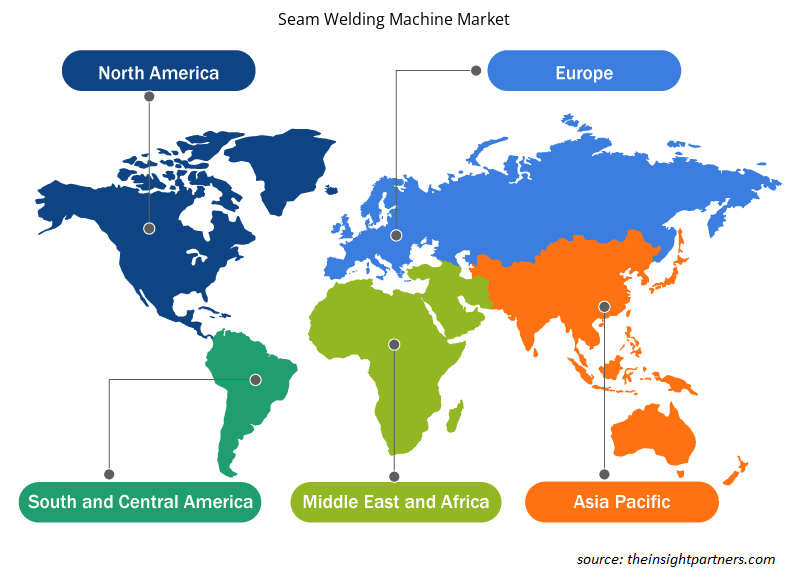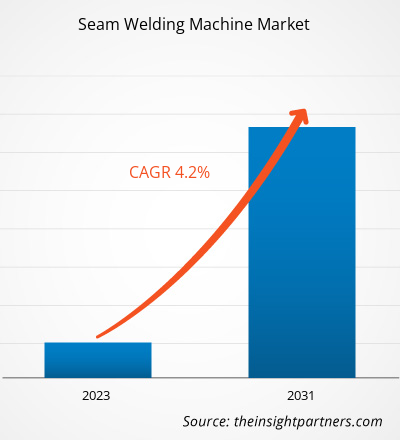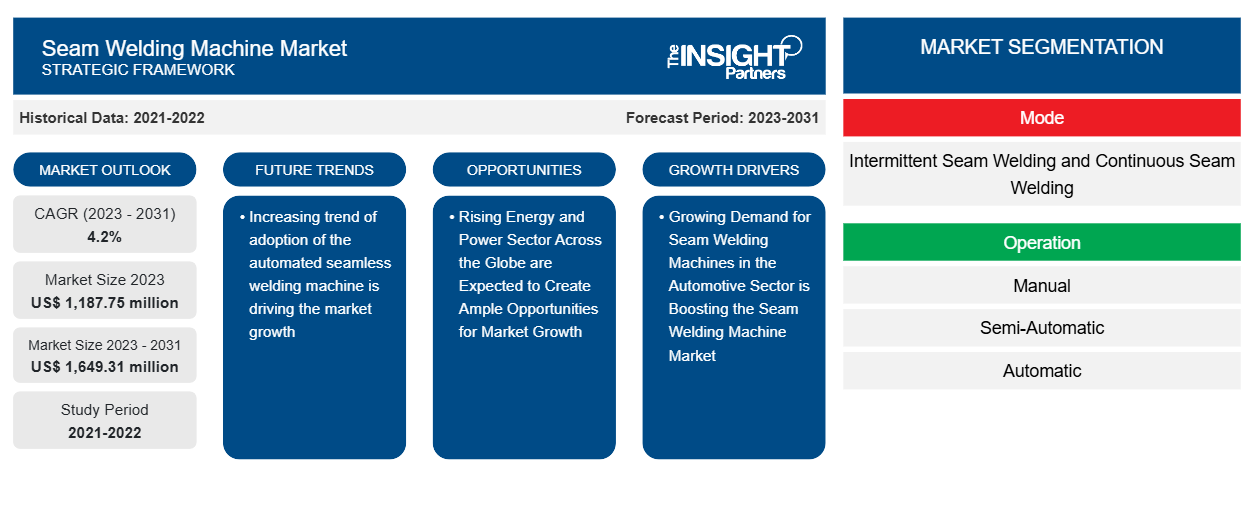Se proyecta que el tamaño del mercado de máquinas de soldadura de costura alcance los 1.649,31 millones de dólares estadounidenses para 2031 desde los 1.187,75 millones de dólares estadounidenses en 2023. Se espera que el mercado registre una CAGR del 4,2% en 2023-2031. Las máquinas de soldadura de costura constan de una o dos ruedas impulsadas por motor que crean una serie de puntos de soldadura superpuestos en los componentes de la chapa de acero para lograr un sellado a prueba de aire y líquido en los componentes soldados. La corriente sin costura pasa a través de estas láminas de rodillos y los componentes soldados se presionan entre ellas. La creciente demanda de máquinas de soldadura de costura en diferentes industrias, incluidas la automotriz, las fabricaciones industriales, la energía de la construcción y la energía, entre otras, impulsa el crecimiento del mercado durante el período de pronóstico.
Análisis del mercado de máquinas de soldadura por costura
El mercado de máquinas de soldadura de costura está dominado por países de Asia Pacífico como India, China, Corea del Sur, Japón y muchos otros. Esto se debe a la creciente demanda de las instalaciones de fabricación de automóviles en los países de Asia Pacífico que impulsa el crecimiento del mercado. Las importaciones de fabricación de componentes automotrices de la India alcanzaron los 20.300 millones de dólares en 2023, con una participación significativa del 30% de China. El gobierno indio está impulsando la fabricación nacional de vehículos eléctricos, lo que impulsa el crecimiento del mercado de máquinas de soldadura de costura.
Personalice este informe según sus necesidades
Obtendrá personalización en cualquier informe, sin cargo, incluidas partes de este informe o análisis a nivel de país, paquete de datos de Excel, así como también grandes ofertas y descuentos para empresas emergentes y universidades.
-
Obtenga las principales tendencias clave del mercado de este informe.Esta muestra GRATUITA incluirá análisis de datos, desde tendencias del mercado hasta estimaciones y pronósticos.
Descripción general del mercado de máquinas de soldadura de costura
Impulsores y oportunidades del mercado de máquinas de soldadura por costura
La creciente demanda de máquinas de soldadura de costura en el sector automotriz está impulsando el mercado de máquinas de soldadura de costura
La producción de automóviles aumentó un 11,5% en 2022 en comparación con 2023, lo que supone unos 92 millones de unidades a nivel mundial. El aumento de la producción impulsa principalmente la demanda de máquinas avanzadas, como las máquinas de soldadura sin costura robóticas para la fabricación de paneles de automóviles por parte de los principales fabricantes de equipos originales de la industria automotriz. Este rápido crecimiento de la producción de vehículos automotrices en las economías avanzadas a nivel mundial ha impulsado el crecimiento del mercado de máquinas de soldadura de costura en el sector automotriz. Además, el aumento de la producción de vehículos eléctricos con la aparición de vehículos eléctricos híbridos está ganando popularidad en el mercado de máquinas de soldadura de costura.
Se espera que el auge del sector energético y eléctrico en todo el mundo cree amplias oportunidades para el crecimiento del mercado
Se espera que la creciente demanda de fabricación de soportes para paneles solares y calderas industriales en el sector de la energía y la electricidad cree una amplia oportunidad para el crecimiento del mercado de máquinas de soldadura de costura durante el período de pronóstico. Por ejemplo, en enero de 2024, Mortenson y Terra-Gen lanzaron el proyecto de almacenamiento de energía y paneles solares más grande llamado Edwards & Sanborn Solar en los EE. UU. Mortenson es el contratista de servicios de adquisición, ingeniería y construcción para este proyecto en los EE. UU. Se espera que el aumento de dichos proyectos en todo el mundo cree una amplia oportunidad para el crecimiento del mercado global de máquinas de soldadura de costura durante el período de pronóstico.Mortenson and Terra-Gen launched the largest solar panel and energy storage project named Edwards & Sanborn Solar in the US. Mortenson is the procurement, engineering, and construction service contractor for this project in the US. Increasing such projects across the globe is expected to create ample opportunity for the global seam welding machine market growth during the forecast period.
Análisis de segmentación del informe de mercado de máquinas de soldadura de costura
Los segmentos clave que contribuyeron a la derivación del análisis del mercado de máquinas de soldadura de costura son el modo, la operación y la industria.
- Según el modo, el mercado se segmenta en soldadura de costura intermitente y soldadura de costura continua. Entre estas, la soldadura de costura continua tiene la mayor participación debido a la creciente demanda en la producción automotriz en todo el mundo.
- Según el funcionamiento, el mercado de máquinas de soldadura de costura se clasifica en manual, semiautomática y automática.
- Según la industria, el mercado está segmentado en construcción, automotriz, petróleo y gas, manufactura y otros. Entre estos, la industria automotriz tiene la mayor participación en 2023, esto se debe al aumento de la producción automotriz en todo el mundo.
Análisis de la cuota de mercado de las máquinas de soldadura por costura por geografía
El alcance geográfico del informe de mercado de máquinas de soldadura de costura se divide principalmente en cinco regiones: América del Norte, Asia Pacífico, Europa, Medio Oriente y África, y América del Sur / América del Sur y Central.
Según la geografía, el mercado de máquinas de soldadura de costura está segmentado principalmente en América del Norte, Europa, Asia Pacífico (APAC), Oriente Medio y África (MEA) y América del Sur (SAM). Se espera que Asia Pacífico represente la mayor participación de mercado en 2023, y es probable que mantenga su dominio durante el período de pronóstico. Además, se espera que el mercado de máquinas de soldadura de costura en esta región sea testigo de la CAGR más alta durante el período de pronóstico. Esto se debe al aumento de la producción automotriz en los países de Asia Pacífico, como China, Japón e India. Por ejemplo, en 2023, los fabricantes de automóviles indios planearon invertir más de US$ 7 mil millones para 2028 para fortalecer su producción local de componentes automotrices, como motores eléctricos, paneles de automóviles, chasis y muchos otros. Además, en marzo de 2024, Autoneum planeó expandir su producción en países de Asia Pacífico como China e India. La empresa planeaba abrir dos nuevas plantas en Pune en el oeste de la India y en Changchun en Jilin, China. El aumento de dicha inversión en el sector automotriz en los países de Asia Pacífico ha creado una demanda masiva para el crecimiento del mercado de máquinas de soldadura de costura.
Se espera que Europa ocupe la segunda mayor cuota de mercado de máquinas de soldadura de costura en 2023. Por el contrario, se espera que Alemania sea el contribuyente dominante al mercado regional de máquinas de soldadura de costura. Europa alberga a los principales fabricantes de automóviles, incluidos Mercedes, Volkswagen, Skoda, BMW y Audi. Según el Departamento de Políticas Económicas, Científicas y de Calidad de Vida, la pandemia de COVID-19 afectó indirectamente a más de 1,1 millones de puestos de trabajo debido al cierre de las fábricas de automóviles entre marzo y mayo de 2020.
Además, las ventas de vehículos se desplomaron en toda Europa en 2020, mientras que los fabricantes de equipos originales (OEM) anunciaron más retrasos en la reapertura de sus plantas de ensamblaje. Además de una caída en la demanda de automóviles de pasajeros y vehículos comerciales ligeros, las interrupciones en las cadenas de suministro de materias primas debido a las limitaciones en los movimientos transfronterizos provocaron retrasos en el suministro de equipos, como máquinas de soldar . Sin embargo, la pandemia de COVID-19 y sus repercusiones alentaron a las empresas manufactureras a digitalizar y automatizar sus operaciones, lo que les permitió reactivarlas a fines de 2020. Estos esfuerzos de reactivación por parte de las empresas manufactureras están creando futuras oportunidades de crecimiento para los proveedores de máquinas de soldadura de costura en Europa.
Perspectivas regionales del mercado de máquinas de soldadura de costura
Los analistas de Insight Partners explicaron en detalle las tendencias y los factores regionales que influyen en el mercado de máquinas de soldadura de costura durante el período de pronóstico. Esta sección también analiza los segmentos y la geografía del mercado de máquinas de soldadura de costura en América del Norte, Europa, Asia Pacífico, Oriente Medio y África, y América del Sur y Central.

- Obtenga datos regionales específicos para el mercado de máquinas de soldadura de costura
Alcance del informe de mercado de máquinas de soldadura por costura
| Atributo del informe | Detalles |
|---|---|
| Tamaño del mercado en 2023 | US$ 1.187,75 millones |
| Tamaño del mercado en 2031 | US$ 1.649,31 millones |
| CAGR global (2023 - 2031) | 4,2% |
| Datos históricos | 2021-2022 |
| Período de pronóstico | 2023-2031 |
| Segmentos cubiertos |
Por modo
|
| Regiones y países cubiertos |
América del norte
|
| Líderes del mercado y perfiles de empresas clave |
|
Densidad de actores del mercado: comprensión de su impacto en la dinámica empresarial
El mercado de máquinas de soldadura de costura está creciendo rápidamente, impulsado por la creciente demanda de los usuarios finales debido a factores como la evolución de las preferencias de los consumidores, los avances tecnológicos y una mayor conciencia de los beneficios del producto. A medida que aumenta la demanda, las empresas amplían sus ofertas, innovan para satisfacer las necesidades de los consumidores y aprovechan las tendencias emergentes, lo que impulsa aún más el crecimiento del mercado.
La densidad de actores del mercado se refiere a la distribución de las empresas o firmas que operan dentro de un mercado o industria en particular. Indica cuántos competidores (actores del mercado) están presentes en un espacio de mercado determinado en relación con su tamaño o valor total de mercado.
Las principales empresas que operan en el mercado de máquinas de soldadura de costura son:
- Compañía Eléctrica Emerson
- Industria eléctrica de Dahching
- Franzan Koike Aronson
- Cª
- Tecnologías Leister
- CruxweldMiller
Descargo de responsabilidad : Las empresas enumeradas anteriormente no están clasificadas en ningún orden particular.

- Obtenga una descripción general de los principales actores clave del mercado de máquinas de soldadura de costura
Noticias y desarrollos recientes del mercado de máquinas de soldadura de costura
El mercado de máquinas de soldadura de costura se evalúa mediante la recopilación de datos cualitativos y cuantitativos posteriores a la investigación primaria y secundaria, que incluye publicaciones corporativas importantes, datos de asociaciones y bases de datos. A continuación, se incluye una lista de los avances en el mercado en materia de innovaciones, expansión comercial y estrategias:
- En 2022, Stealth, un experto mundial en fabricación de equipamiento de alto rendimiento, lanzó una tecnología de soldadura de costuras patentada, pionera en el mercado, que elimina la necesidad de coser. La tecnología da como resultado costuras más cálidas, resistentes y totalmente duraderas para productos más duraderos que protegen a los aventureros de los elementos más duros. (Fuente: Eurofins, comunicado de prensa)
- En 2022, Miller Electric lanzó un sistema de soldadura MIG de alta deposición automatizado de un solo alambre Hercules. El sistema de soldadura Hercules mejora la capacidad de soldadura sin requisitos de costos adicionales relacionados con las celdas de soldadura. Se trata de una máquina de soldadura sin costuras con altas tasas de deposición y mejora la productividad hasta en un 30 %. (Fuente: SGS, Newsletter)
Informe de mercado sobre máquinas de soldadura de costura: cobertura y resultados
El informe “Tamaño y pronóstico del mercado de máquinas de soldadura de costura (2021-2031)” proporciona un análisis detallado del mercado que cubre las siguientes áreas:
- Tamaño del mercado de máquinas de soldadura de costura y pronóstico a nivel global, regional y nacional para todos los segmentos clave del mercado cubiertos bajo el alcance
- Dinámica del mercado, como impulsores, restricciones y oportunidades clave
- Tendencias del mercado de máquinas de soldadura por costura
- Análisis PEST detallado y análisis FODA
- Análisis del mercado de máquinas de soldadura de costura que cubre las tendencias clave del mercado, el marco global y regional, los principales actores, las regulaciones y los desarrollos recientes del mercado.
- Máquina de soldadura de costura Panorama de la industria del mercado y análisis de la competencia que cubre la concentración del mercado, análisis de mapas de calor, actores destacados y desarrollos recientes.
-
Perfiles detallados de empresas
- Compañía Eléctrica Emerson
- Industria eléctrica de Dahching
- Franzán
- Compañía: Koike Aronson, Inc.
- Tecnologías Leister
- Soldadura cruzada
- Soldador Miller
- Construcción de máquinas Schnelldorfer
- Spiro Internacional
- Análisis histórico (2 años), año base, pronóstico (7 años) con CAGR
- Análisis PEST y FODA
- Tamaño del mercado, valor/volumen: global, regional y nacional
- Industria y panorama competitivo
- Conjunto de datos de Excel
Informes recientes
Informes relacionados
Testimonios
Razón para comprar
- Toma de decisiones informada
- Comprensión de la dinámica del mercado
- Análisis competitivo
- Información sobre clientes
- Pronósticos del mercado
- Mitigación de riesgos
- Planificación estratégica
- Justificación de la inversión
- Identificación de mercados emergentes
- Mejora de las estrategias de marketing
- Impulso de la eficiencia operativa
- Alineación con las tendencias regulatorias























 Obtenga una muestra gratuita para - Mercado de máquinas de soldadura de costura
Obtenga una muestra gratuita para - Mercado de máquinas de soldadura de costura